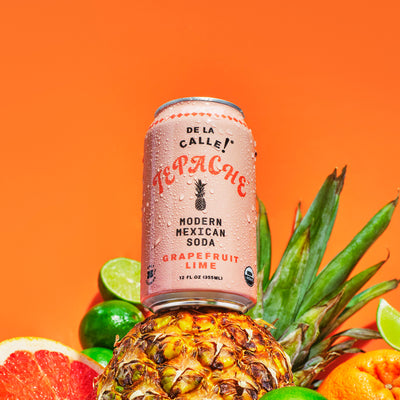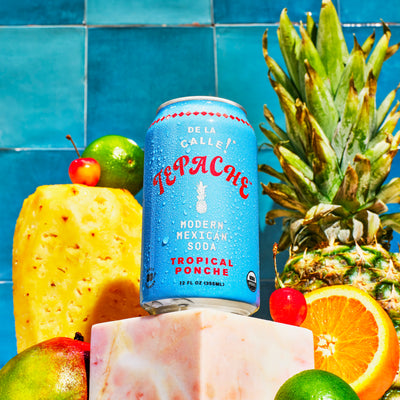Day of the Dead 4 Things You Need To Know

The Day of the Dead, or El Dia de Los Muertos in Spanish, falls on November 1st and 2nd each year. Perhaps you are familiar with the sugar skulls, the ofrendas, the colorful dress, and delicious, authentic Mexican food. Or perhaps this is all new to you!
Whatever your familiarity with the Day of the Dead, there is something to be learned from this read! At De La Calle, we believe first and foremost in community and camaraderie. That’s part of what we love about Dia de Los Muertos—this holiday is meant to bring together families throughout generations.
Much like our tepache, this holiday incorporates modern takes on an ancient tradition. This celebration is an extraordinary and longstanding tradition. On this day, the souls of the deceased can revisit their relatives in the living world. If you were to walk through a Day of the Dead celebration, you’d notice a plethora of candles, skull decorations, and candies all around you.
Here at De La Calle, we believe in the importance of appreciating the traditions that built us. Read on to vamp up your knowledge on The Day of the Dead.
We’ll cover everything from where the day originated from, how to celebrate, and most importantly—how to eat and drink to celebrate the proper way!
1. What Is the Day of the Dead?
The Day of the Dead is celebrated throughout much of Latin America but is most closely associated with Mexico. The day is full of colorful festival celebrations. The lively energy is a mixture of traditions from both Aztec culture and Catholicism spread by Spanish Conquistadors. It’s somewhat related to All Saints’ Day and All Souls’ Day, holidays in the Catholic religion, but it has a much more joyful connotation.
The day is very often associated with Halloween because of the parades and costumes, but their similarities end there.
On The Day of the Dead, the division between the living world and the spirit world is lifted. With the land of the dead’s barrier removed, families who have lost their loved ones have the opportunity to welcome their souls back to Earth.
The souls who crossed over celebrate with their families by eating, drinking, dancing, and reveling in the sweet music of the living world with those they hold most dear. To welcome back their loved ones, families visit the graves of loved ones to leave offerings and create ofrendas where the souls can rest after their long journey.
An ofrenda is an altar placed in the home. The ofrenda holds photos, the favorite foods, and different gifts for the deceased family members. The tradition centers on honoring those who have passed and being together as a family and community.
Ofrendas are often decorated with candles, fruit, tortillas, and flowers. Most commonly, the flowers used are called cempasuchil, or marigolds. Other commonly used symbols for Day of the Dead celebrations are sugar skulls and skeletons, known as calaveras and calacas.
These symbols were somewhat popularized by the painter José Guadalupe Posada. He painted a very famous icon of the holiday of a skeleton woman in brightly colored clothes. The painting is titled La Calavera Catrina, and you’ll see images inspired by it all around.
2. How Does the Day of the Dead Work?
This holiday originated thousands of years ago. On the night of October 31st, beginning at midnight, children’s souls can cross into the living world.
The souls of adults can cross over beginning at midnight on November 1st. The closeness in dates and associations with death is why the Day of the Dead and Halloween are so often closely associated.
3. How To Celebrate the Day of the Dead
Even though this holiday celebrates the dead, it’s infused with vast amounts of life and color. Large gatherings and Day of the Dead parades are used to signify the lifting of the border between the worlds. People often dress in brightly colored costumes and wear masks.
To celebrate this holiday, gather your friends and family together. This tradition celebrates the bonds between loved ones that transcend the physical world. Whether your ofrenda is for one person or one hundred, the best way to honor the day is to be close with those you hold dear.
Come prepared to dance, eat, and laugh. The roots of this holiday lie in not mourning the dead but instead celebrating them.
Celebrators believe that mourning the dead would offend and bring sadness to both the deceased and the living family. So, instead of a day of sorrow and mourning, El Día de Los Muertos is meant for joy.
This holiday celebrates the things that the dead would have enjoyed in life. Dancing, music, friends, loved ones, and delicious food are key to enjoying this festival.
Each year, the holiday takes on new forms and adapts to the changing world around it. However, the heart of the holiday remains unchanged. This is a day meant to celebrate death as a natural part of life.
The Day of the Dead is meant to bring joy to death and remind people of the beauty of being alive.
4. Most Importantly, Food and Drink
Perhaps most importantly, food and drink are central aspects of the celebration on The Day of the Dead.
Some of the food and drink you may see at a Day of the Dead celebration are sugar skulls, chicken tamales, candied pumpkin, and chicken breasts with mole negro. In particular, you may come across Pan de Muerto, a traditional sweet bread with a particular symbol on top that is left as an offering and enjoyed by celebrators throughout the season.
All of these dishes are delicious and a fun way to celebrate the season. You can also try out some tasty tepache if you are looking to dive deeper into Mexican culture and tradition for this holiday.
No matter where, how, or with whom you celebrate this holiday, The Day of the Dead is certain to be a memorable part of your harvest season. The rich cultural history combined with the joyful, celebratory energy of this holiday is sure to make you and your loved ones dance and smile!
¡Feliz Día de Los Muertos!
Sources:
Day of the Dead (Día de los Muertos) | HISTORY












